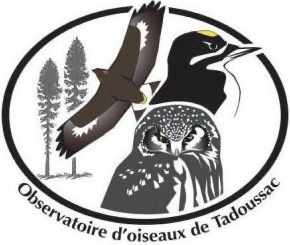Visual surveys
The very project that lead to the creation of TBO, visual surveys have been allowing us to “put our finger on the pulse” of the boreal forest by monitoring more than 100 bird species since 1993.
Yvan-Duchesne lookout
Located on the dunes of Tadoussac, the belvedere is a key vantage point for bird migration observation, both in the spring and in the fall. Historically, the main goal of the visual surveys was to count migrating raptors in the fall in order to assess population trends. Starting in 1996, counts have been broadened to include coastal birds, songbirds, and other closely related species. In 2018, a standardized survey started at the dock in Bergeronnes to document and better understand inverse migration, a phenomenon witnessed in the spring.
Spring
In May 2018, an exceptional phenomenon was reported in several American newspapers, including the New York Times. More than 500,000 warblers were observed in a single day, following a south-west migration path. This one-of-a-kind phenomenon was remarkable not only due to the size of the movement, but also because of the unusual direction the birds were heading, the complete opposite of what is expected for birds at that time of the year. Since then, an expert ornithologist is in charge of daily counts from May 5 to June 6.

A river of warblers
Historically, the reverse migration had been known for several years, but monitoring was sporadic. It should be noted that reverse migrations also concerns others bird species associated with warblers’ arrival in the spring.
Over the years, several movements including thousands of Dark-eyed juncos, White-throated sparrow, American robins, Ruby-crowned kinglets, and flycatchers have been reported.
Since the last decade, numbers of warblers, Purple finches, and Evening grosbeak have been significantly increased, which could be explained in part by the Spruce budworm epidemy, a moth with a 20-to-30- year lifecycle.



Survey protocol
In the face of the exceptional number of birds observed during some of these days, we had to adapt our count methods. Even though it was usually recommended to count and identify all moving birds, since 2023 we had to initiated estimated counts for days of reverse migration.
An imaginary line is created between to counters who are back to back. They count all the birds crossing that line in a minute. The number of birds is then extrapolated for a period of 10 minutes, then the count starts again. In the periods between counts, counters identify species without counting then, to get a general sense of the movement. This protocol is maintained until the flow of birds has clearly subsided. On a few occasions every year, the count has to be carried during the whole day, but it is rare that more than a 1000 birds are counted in a minute.
Why do these reverse migrations occur?
Spring migration is influenced by food availability, temperatures and winds. When the weather conditions are right at night, passerines migrate north in large numbers. Winds of up to 100 km/h between 100 and 1,000 meters above sea level carry the birds farther north in a matter of hours. During particularly favorable evenings, birds from southern Quebec and even the USA, eager to head for their breeding ground, in Charlevoix or Lac Saint-Jean, find themselves on the North Shore. At sunrise, these birds undertake a reverse migration over a variable distance. When the winds blow north-west following these major nocturnal movements, conditions are ideal for witnessing outstanding numbers of passerines at the Tadoussac dunes. The St. Lawrence River acts as a barrier and landmark for these birds on the move.

Recensements printanier – David Turgeon
Autumn
The visual surveys, which began on a standardized basis in 1996, provide a valuable window onto the populations of several bird species, while following the phenology of their migration. From August 24 to November 25 each year, an expert ornithologist carries out daily counts.


13 species of raptorss
Strategically located on the edge of the boreal forest and along the St. Lawrence River, the TBO tracks 13 species of raptors and around 50 passerines and seabirds on a standardized basis. During these three months, an average of 7,000 raptors and over 60,000 passerines are counted. Occasionally, these numbers can reach up to 300,000 passerines.


Migration phenology
The autumn migration of diurnal raptor species is characterized by specific periods. Some, like the Broad-winged Hawk and American Kestrel, leave the region mainly in early September, while others, like the Golden Eagle and Rough-legged Hawk, are mainly seen in October and November.
Migration dates vary according to the age of the individuals. For instance, the young Sharp-shinned Hawk, reach their migration peak around mid-September, while adults are observed around mid-October.

Boreal passerines
A high proportion of the passerines observed at Tadoussac are irruptive boreal species, i.e. they may winter in the boreal forest, but periodically move south of this ecosystem.
The TBO is one of the few North American observatories to collect data on this group of species, which includes several members of the finches family. This information is particularly important for monitoring these species in eastern North America, notably via the “Finch Research Network“.

Monitoring seabirds
Every day, the maximum number of birds observed feeding at the mouth of the Saguenay, as well as on the move, are counted.
The area within the Saguenay-St. Lawrence Marine Park creates conditions renowned for their wealth of food and, consequently, biodiversity. In particular, it is an important wintering bird habitats.
The site also offers exceptional panoramic views, and whale sightings are not uncommon during these counts.
You want to contribute to our mission? Make a donation.
Our research projects rely on government grants and the generosity of our donors. As a not-for-profit organization, a portion of your donation is tax-deductible, while we use 100% of it to continue our mission.
